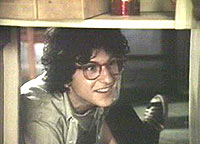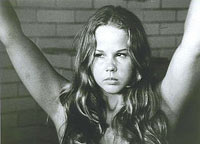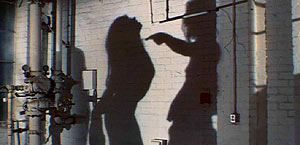1970—1980: Ten Golden Years of Teen Films
Published on November 29th, 2008 in: Issues, Movies, Retrovirus, TV |
Bad Ronald, 1974
Talk about feeling isolated as a teen; you’re lucky you’re not Ronald. Scott Jacoby plays as a socially awkward boy who seems to get along only with his mother. (This can’t be a good thing.) One day, after being rejected by his peers, he’s taunted by a young girl (“You’re weird Ronald”). He pushes and accidentally kills her. Ronald buries her body and confesses to his mother who decides the best course of action is to have him live in the bathroom. (Who wouldn’t come to that conclusion, right?) They dry wall and plaster the doorway closed, removing all traces of the room, save for a small, removable plank in the pantry where he receives food. They work out a system of knocks to keep him safe, especially from the Gladys Kravitz-type neighbor who can’t keep her peepers off the house.
Things go okay for a little while; even the police are fooled into thinking Ronald is gone. Then his mother is hospitalized and dies. Soon a new family with three girls moves in, but Ronald doesn’t move out. He remains in the home spying on them via Norman Bates-like drill holes. He creates an elaborate fantasy world wherein the new family’s teenaged daughter is his princess. He paints imaginary characters in life-sized images on his walls and soon loses whatever sanity he possessed. He believes he must have his princess. The family hears noises in the house. They wonder who is eating all of the food at night. What happened to the nosy neighbor? Where did the middle daughter go? This made-for-TV movie is so bizarre that it’s one of those things where one must shake their head and say, “Only in the seventies.”

Born Innocent, 1974
Linda Blair starred in this made-for-TV movie, an unflinching portrayal of what can become of a young person’s spirit and dreams when they are thrown into an uncaring, inadequate system by their own dispassionate parents. Blair’s character Christine initially makes the best of her situation until she is gang raped by multiple female residents. (The infamous plunger scene was extremely controversial, particularly due to the movie’s prime time airing hours.) Christine initially ran away due to an abusive father, but she decides to return home because of the harsh environment experienced in the juvenile detention center. Unwanted by her father, and with a mother too passive to disagree, Christine remains a resident of this prison for teens. Over time the audience mourns the loss of Christine’s innocence and hope, watching sadly as she grows harder, ignores those who try in vain to help, and rebels against the system that failed her.

Switchblade Sisters, 1975
What’s a girl to do when she moves to a new town and attends a new school? Join a gang, of course! New girl Maggie proves her street smarts and fierce fighting moves in a confrontation with the local girl gang (The Dagger Debs) at the hot dog stand. After being locked up in juvie, the Debs save Maggie from the advances of the aggressive lesbian warden, sealing her membership amongst their ranks. The Dagger Debs were the Pinky Tuscadero to male gang The Silver Daggers’ Fonzie, except peppered with drugs, disrespect, and a bit of date rape. Debs leader Lace and Maggie become fast friends until the old Achilles heel to female relationships—jealousy over a man—leads to conflicting loyalties. Tough girl Patch spurs on the animosity due to her own jealousy of Maggie, and Lace decides something must be done. The Debs rise up in a female frenzy and fight the rival gang led by bad guy and possible STD-sufferer “Crabs.” A turf war, drugs, sex, pregnancy, and violence abound, and all culminate in a showdown at (where else?) the roller rink. Maggie steps into the role of gang leader and enlists a female Black Power gang to help her in her coup d’etat.
One Response to “1970—1980: Ten Golden Years of Teen Films”
June 29th, 2011 at 7:01 pm
[…] popshifter.com […]
Time limit is exhausted. Please reload the CAPTCHA.